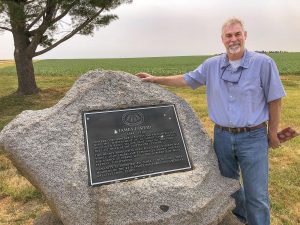Roots of hybrid corn trace back to Tazewell County
By Daniel Grant FarmWeek — August 1, 2023
Matt Shipton, a seed industry representative and descendant of Robert and James Reid, stands by a historical marker at the Tazewell County farm where the Reids developed Reid’s Yellow Dent Corn in the 1800s. (Photo by Daniel Grant)
Those who drive by the northeast side of Delavan on Springfield Road might notice a carved stone that serves as a historical marker.
But while the field where the marker sits looks quite common for the area, the events that took place there in the 1800s were quite remarkable and had a significant impact on production agriculture that are still felt today.
The Tazewell County farm is where Robert and James Reid just happened to mix two different types of corn that transformed the industry. The site is designated as the “birthplace of open-pollinated corn production,” according to Matt Shipton, a descendent of the Reids and a seed industry representative.
The historical marker, erected in 1955, was established by the Tazewell County Farm Bureau and other local groups, the Illinois Department of Agriculture and the Illinois Seed Dealers Association along with the University of Illinois and Michigan State University.
“It’s just fascinating to think of Delavan’s place in the middle of the Corn Belt,” Shipton told FarmWeek.
Shipton recently discussed the history recorded at the site and his ancestors’ role modernizing corn production during Kansas State University’s Grain Export and Supply Chain Expedition. The tour was organized and led by Guy Allen, senior ag economist at K-State and a Delavan native.
Robert Reid (1813-1888) moved to Illinois from Ohio in the mid-1800s and brought some of his own corn. But it wasn’t very good for processing and he had production issues, so he planted some local seeds known as “little yellow” Indian corn in the same field.
“He had missing hills (of corn), so he grabbed some local seed and filled in those missing hills,” Shipton said. “And by happenstance those two pollinated at the same time and created the open-pollinated corn.”
Then, for the next 60 to 70 years, Robert and James Reid (1844-1910) selected the best ears from this new line of corn, which kept improving its agronomic ability each subsequent season.
“They selected the best plants and best ears as they continued that lineage of the open-pollinated line,” Shipton said.
The end result came to be known as Reid’s Yellow Dent Corn. The open-pollinated variety not only dented, but it greatly outproduced most varieties of the late-1800s.
“Common corn yields for that time were around 25 to 35 bushels per acre,” Shipton said. “But by 1877 it was documented James reached 125 bushels per acre.”
Scott Jeckel, a Delavan native currently farming the former Reid property, noted the field produced a yield near 250 bushels last year. But it took nearly 150 years to double the production from what Reid’s Yellow Dent Corn achieved nearly a decade after the Civil War.
“We’ve constantly improved (crop potential),” Jeckel said. “But we’re talking a five-times jump (with what the Reids accomplished in the late-1800s). It was enormous.”
The Reids entered their corn in grain contests and it eventually became a sensation at the 1893 World’s Fair in Chicago. Reid’s Yellow Dent Corn took top honors at that event, officially known as The World’s Columbian Exposition to celebrate the 400th anniversary of Christopher Columbus’s arrival in the New World in 1492.
James Reid subsequently began receiving numerous requests for his corn from around the world. It’s said he fulfilled many of those requests by mailing Reid’s Yellow Dent Corn seed from the local post office in Delavan.
“By 1920 it was grown in every state and by 1930 an estimated 75 percent of corn grown in the U.S. could be traced back to Reid’s Yellow Dent Corn,” Shipton said. “Many reported it increased productivity in local areas where it was planted.
“But (James Reid) never became wealthy off the process,” he noted. “It sounds like he was more willing to give the seed away to help others have additional yield on their farms.”
Hybrid corn varieties were then introduced in the 1920s and overtook their open-pollinated predecessors, constituting nearly 100 percent of cultivation in the Corn Belt by the end of the 1930s.
But the source of a number of inbred lines used as parents of many present-day corn hybrids still have roots to the accidental discovery of a lifetime, when the Reids inadvertently created their open-pollinated, yellow dent corn.
This story was distributed through a cooperative project between Illinois Farm Bureau and the Illinois Press Association. For more food and farming news, visit FarmWeekNow.com.







